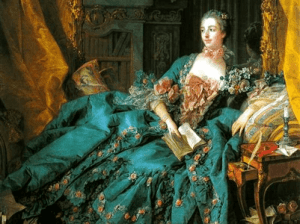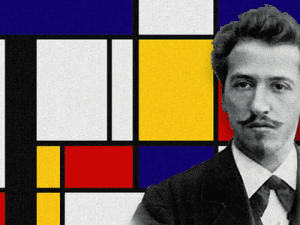(Skip to bullet points (best for students))

Born: 1828
Died: 1882
Summary of Dante Gabriel Rossetti
Dante Gabriel Rossetti earned his reputation as a founding member of the Pre-Raphaelite Brotherhood, and was later recognised by history as an imaginative yet controversial nonconformist. By seeking for inspiration and holy instruction in mediaeval art, the Brotherhood attacked the “decadent” pleasures of the day. Rather of creating dramatic historical narratives (as was the vogue at the time), The Brotherhood adhered to a rigid set of puritanical and aesthetic norms, which Rossetti quickly became bored of.
He continued to paint his mythological tales with the same brightness and attention to the tiniest image detail, but Rossetti, who yearned to be recognised as a poet as well as a painter, became obsessed with the notion of feminine beauty. Despite the fact that his licentious lifestyle was criticised by many of his peers, it gave his art erotic vitality and, it must be stated, true individuality. However, his reckless lifestyle eventually led to his mental deterioration, which, as is frequently the case, further added to his legacy as a prolific Victorian maverick.
Rossetti, a key figure in the Pre-Raphaelite Brotherhood movement, reflected on a time before the High Renaissance. He was inspired by the purity and symbolism of mediaeval and holy stories seen in Florentine and Sienese painting from the 15th century.
Rossetti is well known for his portrait paintings. His preferred subject matter was religious, but as he grew as an artist, his work became increasingly contentious due to his propensity of utilising family members and lovers to portray sacred symbols.
Morris, Marshall, Faulkner & Co., a furniture and decorating firm, was founded by Rossetti. The business, which was founded in 1861, was known for its intricate and vibrant patterns. Rossetti’s designs serve as a visible link between the Pre-Raphaelite Brotherhood and William Morris’s Arts and Crafts movement, even though he quickly lost interest in decorative arts and his relationship with Morris suffered as a consequence.
Rossetti had a life-long desire to become a poet in the mould of his heroes Dante (his namesake), Byron, and Keats, and had wished to leave painting in his latter years. Critics, on the other hand, believed his published collection was too verbose, and this setback was supposed to have led to a slowdown in his artistic production, and was even recognised as a cause for his drug addiction and mental decline.
Childhood
Gabriel Charles Dante Rossetti was born in London in May 1828 to Italian emigrants. Gabriel Pasquale Giuseppe Rossetti, the boy’s father, was a scholar and poet who had been banished from Italy for his support for revolutionary nationalism. He was Professor of Italian at Kings College from 1831. Frances Mary Poldari, his English-Italian mother, was the daughter of an exiled noble Italian scholar who, in addition to her parental obligations, worked as a private teacher. Because of the couple’s extensive literary and cultural backgrounds, their love of study was handed down to all four of their children: Gabriel, Christina, William, and Maria.
Gabriel Charles Dante wanted to be addressed by his middle name, Dante, from an early age in order to stress his connection to the mediaeval Italian poet and writer (about whom his father had written extensively). Dante had been immersed by mediaeval Italian art and literature since he was a child, and had written plays, poems, and paintings in this style. Through a combination of home instruction and study at Kings College, Dante was able to develop his precocious skills (for painting and writing). He grew to appreciate biblical passages, Shakespearean tragedies, Edgar Allan Poe, and Byron’s poetry.
He was divided between wanting to be a poet and wanting to be a painter as a youth, and he often stated that writing and poetry were his genuine loves.
Early Life
Between 1841 to 1845, Rossetti studied at Henry Sass Drawing Academy, and then for another three years at the Royal Academy’s Antique School. Rossetti had a lot of practical expertise behind him by 1848, when he was just twenty years old, yet he found himself at conflict with the Victorian art establishment. The Academy’s painting looked to Rossetti to be full of emotional, fussy, and moralistic settings, as well as stiff, snobby portraits. Rather, Rossetti was inspired by the work of Ford Madox Brown, who was known for his attention to detail, graphic style, and bold use of colour. This style was far more akin to Rossetti’s favourite brilliant mediaeval paintings.
Rossetti saw a picture called The Eve of St Agnes, by a young artist named William Holman Hunt, during an exhibition in the mid-1840s. The artwork depicted a poem by John Keats that isn’t well-known. Rossetti, like Holman Hunt, was a Keats fan, and he found in Hunt a kindred spirit who shared his creative aspirations and a desire to challenge the Academy’s vacuous façade. Rossetti and Hunt began sharing flats in Fitzrovia, where Rossetti met John Everett Millais, a student of Holman Hunt’s at the Royal Academy of Arts. The three painters gathered in 1848 at Millais’ parents’ house on Gower Street to create the Pre-Raphaelite Brotherhood’s first formal meeting (PRB).
The Brotherhood’s beliefs were numerous and, in some respects, complicated. People like the prominent critic John Ruskin had identified Rossetti as the Brotherhood’s de-facto head, and it was Rossetti who was keen to gather together a diverse collection of artists. However, Holman Hunt said in his memoirs that it was he and Millais who were the driving forces behind the Brotherhood’s formation, and that Rossetti was, at heart, a poet (more than a painter).
The Brotherhood aspired to restore to a period before to Raphael’s and the Mannerists’ supremacy, emulating the spiritual, mythical, and mediaeval while paying close attention to strong colorization and exquisite image detail. The painters had a lot in common: complex and symbolic compositions, jewel brilliant colours, precise brushwork, and lyrical and historical connections. John Ruskin, the famous critic, wrote: “Every Pre-Raphaelite landscape backdrop is hand-painted in the open air, right down to the last detail. Every Pre-Raphaelite figure is a real picture of a living person, no matter how refined in expression “..
The Brotherhood established its own journal, The Germ, to publish its thoughts and poems. The magazine was not only connected with the seven members of the brotherhood, but also with individuals like as Christina Rossetti (Dante’s sister), Madox Brown, and the movement’s critical advocate, John Ruskin. In 1850, the first edition was released, and the Pre-Raphaelite Brotherhood’s public face was born.
It stated, ” “This Periodical was developed in order to collect the opinions of Artists on Nature as it has evolved in Art. It is not intended to enunciate the principles of those who, in the true spirit of Art, enforce a rigid adherence to the simplicity of Nature in Art or Poetry; rather, it is intended to enunciate the principles of those who, in the true spirit of Art, enforce a rigid adherence to the simplicity of Nature in Art or Poetry.”
Rossetti, on the other hand, drew criticism from the start. Rossetti, for example, employed a complex variety of biblical symbolism and bright colours to create vibrant scenarios set in mediaeval Mediterranean-styled environs in a series centred on the early life of Christ and the Virgin Mary. The way the sacred characters were presented as human flesh-and-blood, however, astounded the audience. While the Victorian audience was ready to accept a stylistic shift, they were taken aback by the way the entire serious process of painting biblical subjects appeared to have been flipped upside down.
Mid Life
Rossetti abandoned elaborate religious subjects in favour of pursuing his fascination with female beauty, which he mostly addressed via portraiture. Indeed, mythical portraits took up the majority of Rossetti’s career, and the goddesses, tragic heroines, and saints he created were based on a small group of lovers and muses. Elizabeth Siddal captivated Rossetti to the point of ecstasy. When Dante was 19 and working as a milliner’s assistant in 1850, he met Siddal, who was also an aspiring artist. She quickly established herself as Rossetti’s model, pupil, lover, and muse (she also modelled for other Pre-Raphaelite painters, most notably as John Everett Millais’ Ophelia (1851-52)).
Siddal was the subject of some of Rossetti’s most loving drawings and poems. Despite their marriage (in 1860), their relationship was turbulent, with Rossetti’s philandering and Siddal’s laudanum addiction not helping matters. Elizabeth Siddal died in February 1862 after taking an overdose of laudanum after being saddened by another year of Rossetti’s relationships and suffering her own miscarriage. Rossetti buried his half-finished poetry work with his wife, putting it under her hands and encircled by her swaths of copper coloured hair, overtaken by sadness and shame. In his painting Beata Beatrix, he idealised her as Dante’s Beatrice (1864-70).
Rossetti had sexual encounters with numerous other renowned models while married to Siddal, one of them being Fanny Cornforth. Cornforth modelled for Rossetti’s more sensual portraits, whilst Siddal liked to pose for legendary women. Despite the fact that Corthworth had worked as a domestic servant and a prostitute, there was an obvious social divide between the two, Rossetti admired Cornforth and the two stayed close until his death. Jane Morris was Rossetti’s second significant romance outside of his marriage.
Jane was the unhappy wife of his younger contemporary and admirer, William Morris, and had known Rossetti, for whom she had also posed, since the late 1850s. Rossetti and William Morris got even closer when they established a Furnishing and Decoration firm (Morris & Co.) together in 1861. Their affair is thought to have started in 1865 and intensified after William Morris left them alone for a summer to decorate the couple’s new house in 1871 (perhaps with some knowledge of the couple’s secret connection).
Late Life
Rossetti’s behaviour got increasingly unpredictable after Lizzie’s death. He moved into a Tudor House in Chelsea’s Cheyne Walk, followed by Fanny, his “housekeeper.” who lived nearby. Rossetti had opulent furnishings and unusual creatures, including a wombat, a toucan sporting a cowboy hat, and a llama! Watercolorist Henry Treffry Dunn remembered such features as a “original make-up of Chinese black-lacquered panels bearing designs of birds, animals, flowers and fruit in gold relief.” among other things.
Rossetti’s portraits of beauties remained prolific throughout the 1860s and early 1870s. He not only continued to paint Fanny and Jane Morris, but he also found Alexa Wilding, a designer and performer. During this time, he painted more finished paintings of Wilding than any of his other figures. This might be owing to the fact that, although being good friends, they were not romantically involved.
Rossetti was anxious to fulfil his longstanding dream of becoming a poet by this point in his life. His primary corpus of poetry, however, was buried at Highgate Cemetery with Lizzie Siddall. Rossetti exhumed his wife’s tomb in an impulsive move in 1870. In the same year, he released his first collection of poems, Poems by D.G Rossetti. However, the piece was critically panned, with writer Robert Buchanan dismissing it as an example of “the fleshly school of poetry” In the summer of 1872, he had a mental breakdown due to sadness over the poor reception of his poetry and a slowdown in his painting productivity.
Rossetti began self-medicating with whiskey and chloral hydrate until he developed a serious addiction. When William Morris fired Rossetti from their common decorative arts business in 1874, his situation deteriorated much further.
Rossetti remained a hermit at Cheyne Walk for the rest of his life, housebound owing to alcohol psychosis, liver disease, and limb paralysis. At the age of 53, he died on Easter Sunday, 1882. Fanny Cornforth had visited and nursed Rossetti till the very end (even after she married another man in 1879). His most sensual and passionate model and lover became a longtime companion and confidante, passing on many of Rossetti’s paintings and mementos to future generations.
Rossetti was a driving force behind the Brotherhood, as were the painters who followed after him in the second wave of the Brotherhood, which began in the 1850s. This includes William Morris, Edward Burne-Jones, and John William Waterhouse, among others. This generation adored Rossetti, especially his colourful mediaeval style, and Rossetti had a significant effect on the Arts and Crafts Movement, which Morris founded in the 1880s. Rossetti was hailed as a forerunner of Aestheticism and European Symbolism after his death. Artists and poets like Aubrey Beardsley and Oscar Wilde were influenced by the worship of beauty and “art for art’s sake” as well as a decadent way of living.
Famous Art by Dante Gabriel Rossetti
The Girlhood of Mary Virgin
1849

Rossetti’s Girlhood of Mary Virgin is considered to be his first mature picture. Rossetti wanted to display the picture at the Free Exhibition at the Hyde Park Corner Gallery the following spring, a year after cofounding the Pre-Raphaelite Brotherhood (in 1848). The artwork depicts the youthful Virgin Mary embroidering a flower at a table with her mother, Anne. Mary’s father, Joachim, is seen in the distance pruning a vine in a lush green garden that has been visited by a haloed dove. A thorn and a crossed palm branch are at the women’s feet. A kid angel waters a vase with the prop of the lily on the left hand side of the image frame.
Bocca Baciata
1859

Rossetti had been married to Elizabeth Siddal for nine years by the time he finished Bocca Baciata (in 1859). He created thousands of loving drawings of his future bride during that period (they were married in 1860). However, his mistress, Fanny Cornforth, served as the model for this, the first of his painted female portraits. Rossetti depicted Fanny as his ideal of sexual desire and appeal, whereas he represented Elizabeth as a lovely, ethereal person.
Proserpine
1874

Rossetti was suffering from a mental collapse by 1874, which was exacerbated by his dependence on chloral hydrate and alcohol. He remained at 16 Cheyne Walk for the final 10 years of his life, when he was tended by Fanny Cornforth and visited on a daily basis by his girlfriend, Jane Morris. Morris had become something of an obsession for Rossetti, who had never completely owned her owing to her miserable marriage to William Morris (with whom, it is said, she stayed married for the sake of their children). Rossetti, on the other hand, created several portraits of Jane during the 1870s.
BULLET POINTED (SUMMARISED)
Best for Students and a Huge Time Saver
- Dante Gabriel Rossetti earned his reputation as a founding member of the Pre-Raphaelite Brotherhood, and was later recognised by history as an imaginative yet controversial nonconformist.
- By seeking for inspiration and holy instruction in mediaeval art, the Brotherhood attacked the “decadent” pleasures of the day.
- Rather of creating dramatic historical narratives (as was the vogue at the time), The Brotherhood adhered to a rigid set of puritanical and aesthetic norms, which Rossetti quickly became bored of.
- Despite the fact that his licentious lifestyle was criticised by many of his peers, it gave his art erotic vitality and, it must be stated, true individuality.
- However, his reckless lifestyle eventually led to his mental deterioration, which, as is frequently the case, further added to his legacy as a prolific Victorian maverick.
- Rossetti, a key figure in the Pre-Raphaelite Brotherhood movement, reflected on a time before the High Renaissance.
- He was inspired by the purity and symbolism of mediaeval and holy stories seen in Florentine and Sienese painting from the 15th century.
- Rossetti is well known for his portrait paintings.
- The business, which was founded in 1861, was known for its intricate and vibrant patterns.
- Rossetti had a life-long desire to become a poet in the mould of his heroes Dante (his namesake), Byron, and Keats, and had wished to leave painting in his latter years.
Information Citations
En.wikipedia.org, https://en.wikipedia.org/.
Recommend0 recommendationsPublished in Artists







Responses